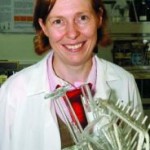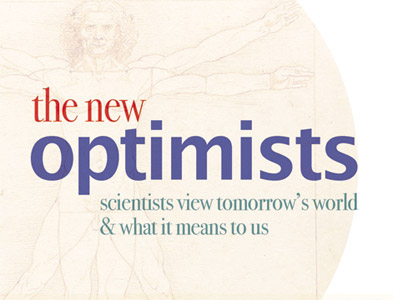Posts Tagged ‘Aston University’
June 24th, 2010
Climate change is the big challenge of our time. There is growing realisaation that we are damaging our children’s chances of survival unless we act to reduce carbon and other emissions, says software engineer Professor Robert Berry.
 So why might this possibly insurmountable challenge be the cause for his optimism? He’s an engineer. And engineers love problems, especially problems with lots of constraints. Devising alternative sources of energy, whilst also responding to increasing demand, is perhaps the biggest challenge facing humanity, and the constraints enormous and varied . . .
So why might this possibly insurmountable challenge be the cause for his optimism? He’s an engineer. And engineers love problems, especially problems with lots of constraints. Devising alternative sources of energy, whilst also responding to increasing demand, is perhaps the biggest challenge facing humanity, and the constraints enormous and varied . . .
Professor Berry joined Aston University as Dean of the School of Engineering and Applied Science in 2008. Before this, he was IBM Distinguished Engineer with IBM UK in Hursley, Hampshire. His research interests lie in developing techniques for understanding and improving the performance of large complex software systems.
Tags: Aston University, climate change, energy, engineering, IBM, robert berry
Posted in People, The Ways of Science, Thinking differently | No Comments »
June 23rd, 2010
The public rarely has the opportunity to visit a working laboratory. Yet what goes on in our labs and research groups will help shape the future of us all. The public engagement of science — i.e. non-scientists, ordinary men and women knowing what goes on in our labs and universities helps us all understand the societal implications of research.
This is a form of democratic empowerment, says Dr Anthony Hilton, where the agenda is in the hands of the non-expert.
 Dr Hilton is a Reader in Microbiology at Aston University undertaking world-class research. He’s also heavily committed to the public engagement of science. He’s taken his professional life into our living rooms through the BBC series Grime Scene Investigation and the One Show. In 2009, he received the Society for Applied Microbiology Communication Award, and the Aston Excellence Award for his contribution to community engagement. (For an example, see Aston University’s Microbiology Roadshow.)
Dr Hilton is a Reader in Microbiology at Aston University undertaking world-class research. He’s also heavily committed to the public engagement of science. He’s taken his professional life into our living rooms through the BBC series Grime Scene Investigation and the One Show. In 2009, he received the Society for Applied Microbiology Communication Award, and the Aston Excellence Award for his contribution to community engagement. (For an example, see Aston University’s Microbiology Roadshow.)
His current research group is working on projects including the molecular epidemiology of hospital and community MRSA, phenotypic and genotypic characterisation of Clostridium difficile, the role of flying insects in the spread of hospital-associated pathogens and Salmonella carriage in companion animals.
Anthony Hilton is on Facebook.
Tags: anthony hilton, Aston University, clostridium difficile, grime scene investigation, microbiology, MRSA, pathogens
Posted in People, The Ways of Science, Thinking differently | No Comments »
June 23rd, 2010
At the heart of Brian Tighe‘s contribution to The New Optimists, is the inspiring and in many ways astounding story of how contact lenses were invented, a testament to the persistence and invention of scientists.
 Professor Tighe is leader of Biomaterials Research at Aston University. His own research focuses on the design, synthesis and applications of biomedical polymers, a significant proportion of which are hydrogels, a term frequently used to describe polymers swollen with water. Current interests include novel materials for ophthalmic applications, drug delivery systems, bioadhesive polymers, synthetic materials for articular cartilage, lung surfactant and cornea. The research is interdisciplinary and involves strong interactive connections with relevant industrial companies.
Professor Tighe is leader of Biomaterials Research at Aston University. His own research focuses on the design, synthesis and applications of biomedical polymers, a significant proportion of which are hydrogels, a term frequently used to describe polymers swollen with water. Current interests include novel materials for ophthalmic applications, drug delivery systems, bioadhesive polymers, synthetic materials for articular cartilage, lung surfactant and cornea. The research is interdisciplinary and involves strong interactive connections with relevant industrial companies.
Tags: Aston University, biomaterials, brian tighe, contact lenses, ophthalmics
Posted in People, The Ways of Science, Thinking differently | No Comments »
June 23rd, 2010
In the study of human behaviour, there is a new fascination with strengths, potential and values. This new orientation, says Michael West of Aston Business School, has revealed astonishing and immensely encouraging ways to promote health and well-being among people, groups and communities.
 Professor Michael West is Dean at Aston Business School. He has authored, edited or co-edited 16 books and published over 150 articles for scientific and practitioner publications as well as chapters in scholarly books.
Professor Michael West is Dean at Aston Business School. He has authored, edited or co-edited 16 books and published over 150 articles for scientific and practitioner publications as well as chapters in scholarly books.
He is a Fellow of the British Psychological Society, the American Psychological Association, the International Association of Applied Psychologists, is a Chartered Fellow of the Chartered Institute of Personal and Development. His areas of research interest are team and organisational innovation and effectiveness, particularly in relation to the organization of health services. He lectures widely both nationally and internationally about the results of his research and his ideas for developing effective and innovative healthcare organisations.
Tags: Aston Business School, Aston University, Michael West
Posted in People, The Ways of Science, Thinking differently | No Comments »
June 23rd, 2010
You may think that your body is yours, and yours alone. But it’s not. You’re sharing it . . . there are 10 microbes for every single cell in your body. Each one of us, within (what we think of as) our very own self, is outnumbered ten to one.
 The world of microbes is an incredible one, unseen, unimagined by humankind until the invention of lenses. The work of microbiologists such as Professor Peter Lambert enable us literally to see and understand our world quite differently.
The world of microbes is an incredible one, unseen, unimagined by humankind until the invention of lenses. The work of microbiologists such as Professor Peter Lambert enable us literally to see and understand our world quite differently.
It’s a microscopic view of the world that helps us understand how it is we live, eat and breath, what viruses and bacteria there are within us and in the world, and how they affect us . . . Harnessing the power of microbes could even provide the answer to finding sources of energy that do not contaminate the world.
Peter Lambert is Professor of Microbiology in the School of Life and Health Sciences at Aston University. His main research interests are in infections caused by bacteria, particularly how they can be treated with antibiotics and what can be done when bacteria become resistant to antibiotics. This has been of increasing concern over the past 10 years with the emergence of hospital acquired infections due to bacteria such as MRSA and Clostridium difficile. Broader interests concern the diversity of bacteria in the world and how microbes can be used in the service of mankind.
Tags: Aston University, clostridium difficile, microbes, microbiology, MRSA, peter lambert
Posted in The Ways of Science, Thinking differently | No Comments »
June 21st, 2010
Probability theory may sound like arcane and irrelevant mathematics, but it’s the stuff that enables us to work with uncertainty. Imagine a random event such as a heart attack, something that rarely happens but when it does, it has devastating effects. It’d be helpful if we could work out just how likely such an event would be without having to take up the time and resources of expert cardiologists.
 Ian Nabney, a Professor of Computer Science at Aston University, works with modern computing power which vastly expands the range of problems that can be tackled. Couple probability theory with machine learning (the design and development of algorithms that allow computers to evolve behaviors based on empirical data, such as from sensor data or databases), for example, and, he says, we can put a lot of the decision-making expertise and power of the best of cardiologists on a ‘box’ can be used by a non-expert.
Ian Nabney, a Professor of Computer Science at Aston University, works with modern computing power which vastly expands the range of problems that can be tackled. Couple probability theory with machine learning (the design and development of algorithms that allow computers to evolve behaviors based on empirical data, such as from sensor data or databases), for example, and, he says, we can put a lot of the decision-making expertise and power of the best of cardiologists on a ‘box’ can be used by a non-expert.
Professor Nabney is a member of Aston’s Non-linearity and Complexity Research Group and his research is in pattern analysis. Â He specialises in developing applications with industrial and medical partners in such areas as data visualisation, energy price forecasting, and probabilistic models of risk in jet engine design. Â His software toolbox, Netlab, has over thirty-five thousand users around the world, and can be downloaded here; see also his book NETLAB: Algorithms for Pattern Recognition.
Tags: Aston University, cardiology, ian nabney, machine learning, netlab, neural networks, probability theory
Posted in People, The Ways of Science, Working together | No Comments »
June 21st, 2010
 Dr Ann Vernallis studies small proteins called cytokines. Although most people will never have heard of them, abnormal increases or decreases in cytokine levels are associated with a variety of diseases. Researchers have been interested in them for years; medical interest really took off when anti-TNF (tumour necrosis factor) treatment was developed for rheumatoid arthritis — an example of the beneficial interplay of basic and clinical sciences.
Dr Ann Vernallis studies small proteins called cytokines. Although most people will never have heard of them, abnormal increases or decreases in cytokine levels are associated with a variety of diseases. Researchers have been interested in them for years; medical interest really took off when anti-TNF (tumour necrosis factor) treatment was developed for rheumatoid arthritis — an example of the beneficial interplay of basic and clinical sciences.
Dr Ann Vernallis is a Lecturer in the School of Life and Health Sciences at the University of Aston. She’s interested in cell signalling. As a post-doctoral fellow, she studied cytokine receptor interactions in the IL-6 family. At Aston, she’s studied the secretion of Leukemia Inhibitory Factor (LIF), the pro-inflammatory activities of lipoteichoic acid from Gram-positive bacteria and cytokine levels in patients with infections. She’s currently working on the anti-inflammatory effects of tetracyclines, and she collaborates on studies of neuron/astrocyte interactions in a neuronal stem cell model.
Tags: ann vernallis, anti-TNF factor, Aston University, cell signalling, cytokines, life sciences, proteins, rheumatoid arthritis
Posted in People, The Ways of Science, Working together | No Comments »
June 21st, 2010
 One of many intriguing aspects of human language is it varies in predictable ways across social groups. In understanding this variation, argues Dr Tim Grant of Aston’s Centre for Forensic Linguistics, we are sometimes able to locate the social origins of a particular text.
One of many intriguing aspects of human language is it varies in predictable ways across social groups. In understanding this variation, argues Dr Tim Grant of Aston’s Centre for Forensic Linguistics, we are sometimes able to locate the social origins of a particular text.
This expertise is important in a variety of settings. Imagine, for example, that owing to certain pressures, you had falsely confessed to a serious crime, and ‘words have been into your mouth’ by a police officer . . . How might this be uncovered?
In the world of the police and of the courts, linguists such as Dr Grant are joining psychologists in the role of investigative advisor. (For a Crimewatch interview with Dr Grant, please click here.)
Dr Tim Grant is Deputy Director of the Centre for Forensic Linguistics at Aston University. His consultancy primarily involves authorship analysis and he has worked in many different contexts including investigations into sexual assault, murder and terrorist offences. He publishes on forensic linguistics and forensic psychology and his research into text messaging analysis was awarded the 2008 Joseph Lister Prize by the British Science Association. He considers himself a natural optimist.
See also An Introduction to Forensic Linguistics: Language in evidence by the Centre’s Director Malcolm Coulthard and Leeds University’s Alison Johnson.
Tags: Aston University, centre for forensic linguitsics, crimewatch, forensic linguistics, linguistics, tim grant
Posted in Changing behaviour, People, Transformations | No Comments »
June 19th, 2010
 The necessity for new vaccines is urgent and evident. Despite humanity’s success in eradicating smallpox, two other infectious diseases — malaria and TB, remains tow of the world’s primary killers. The combination of either with HIV is lethal. Infectious agents are also implicated as causes of cancer.
The necessity for new vaccines is urgent and evident. Despite humanity’s success in eradicating smallpox, two other infectious diseases — malaria and TB, remains tow of the world’s primary killers. The combination of either with HIV is lethal. Infectious agents are also implicated as causes of cancer.
There is good news, though says Professor Yvonne Perrie of Aston University. Several laboratories around the world are working on new vaccines and their delivery. Indeed her own research is focused on the advancements and strategic development of drug delivery systems to facilitate effective delivery and targeting of drugs and of vaccines.
Yvonne Perrie is Professor in Pharmaceutics and Drug Delivery, as well as being Head of Pharmacy at Aston University. She is also co-author (with Thomas Rades) of FASTtrack: Pharmaceutics – Drug Delivery and Targeting.
The specific fields of her research are the formulation engineering of vaccines (including conventional and DNA vaccines); enhancing solubility and delivery of bioactive molecules using colloid science and technology; the delivery of drugs, vaccines and gene therapies using liposomes, niosomes and other novel particulate systems; the design, physicochemical characterisation and development of non-viral systems for gene delivery; tissue engineering and regenerative medicine as well as enhancing learning methods in Pharmacy Education.
Tags: Aston University, Cancer, drug delivery, HIV, malarria, pharmaceutics, pharmacology, pharmacy. life sciences, TB, vaccines, yvonne perrie
Posted in Getting to the heart of things, People, Transformations | No Comments »
June 15th, 2010
 Urban ecosystems are important for two major reasons, says Dr Lucy Bastin of Aston University. First, the urban environment is where most people spend most of their time, Secondly, urban areas have a huge undervalued resource in all those scruffy patches of derelict land; biodiversity on urban brownfield sites is often surprisingly impressive.
Urban ecosystems are important for two major reasons, says Dr Lucy Bastin of Aston University. First, the urban environment is where most people spend most of their time, Secondly, urban areas have a huge undervalued resource in all those scruffy patches of derelict land; biodiversity on urban brownfield sites is often surprisingly impressive.
Dr Bastin is a lecturer in GIS (Geographical Information Systems) at Aston University. She applies spatial analysis techniques to health, environmental and socio-demographic research challenges. She started out working for the Birmingham Urban Wildlife Trust, and then studied for a BSc in Zoology (Nottingham) and a PhD in the population ecology of urban plants (Birmingham). She has also worked as a researcher on fuzzy classifications of satellite imagery, and spent several years as a senior software developer at Tadpole-Cartesia.
Tags: Aston University, lucy bastin, population ecology, urban ecology
Posted in Living in the natural world, People, The Macrocosm | No Comments »
 So why might this possibly insurmountable challenge be the cause for his optimism? He’s an engineer. And engineers love problems, especially problems with lots of constraints. Devising alternative sources of energy, whilst also responding to increasing demand, is perhaps the biggest challenge facing humanity, and the constraints enormous and varied . . .
So why might this possibly insurmountable challenge be the cause for his optimism? He’s an engineer. And engineers love problems, especially problems with lots of constraints. Devising alternative sources of energy, whilst also responding to increasing demand, is perhaps the biggest challenge facing humanity, and the constraints enormous and varied . . .
















